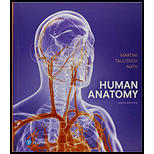
Human Anatomy (9th Edition)
9th Edition
ISBN: 9780134320762
Author: Frederic H. Martini, Robert B. Tallitsch, Judi L. Nath
Publisher: PEARSON
expand_more
expand_more
format_list_bulleted
Concept explainers
Question
Chapter 20, Problem 1RC
Summary Introduction
Introduction:
Red blood cells (RBCs) or erythrocytes carry oxygen from lungs to different tissues of the body. There are different blood types namely, type A, B, AB, and O, which is based on the presence of a specific surface antigen on the plasma membrane of the RBCs. Apart from the blood group type, the rhesus (Rh) factor is also considered for checking the compatibility between different blood group types.
Expert Solution & Answer
Want to see the full answer?
Check out a sample textbook solution
Students have asked these similar questions
Hemolytic disease of the newborn can result if, (a) the mother is Rh-positive and the father is Rh-negative. (b) both the father and the mother are Rh-negative. (c) both the father and the mother are Rh-positive. (d) an Rh-negative woman carries an Rh-positive fetus.
A person with type A blood has, (a) anti-A antibodies in the plasma. (b) B antigens in the plasma. (c) A antigens on red blood cells. (d) anti-B antibodies on red blood cells.
An individual demonstrates antibodies (A) and antibodies (B) in their blood. Their blood type would be which of the following?
(A) AB+
(B) AB-
(C) AB ? (presence/absence of Rh factor undetermined)
(D) O+
(E) O-
(F) O ? (presence/absence of Rh factor undetermined)
Chapter 20 Solutions
Human Anatomy (9th Edition)
Ch. 20 - The five figures to the right are labeled a...Ch. 20 - Prob. 2RFTCh. 20 - Prob. 3RFTCh. 20 - The most abundant proteins in blood are (a)...Ch. 20 - 5. The major classes of white blood cells...Ch. 20 - Prob. 6RFTCh. 20 - Prob. 7RFTCh. 20 - Prob. 8RFTCh. 20 - Prob. 9RFTCh. 20 - Prob. 10RFT
Ch. 20 - 11. Platelets are
(a) large cells that lack a...Ch. 20 - Prob. 1RCCh. 20 - Prob. 2RCCh. 20 - Prob. 3RCCh. 20 - Prob. 4RCCh. 20 - Prob. 5RCCh. 20 - What is the fate of megakaryocytes?Ch. 20 - Prob. 7RCCh. 20 - Prob. 8RCCh. 20 - Prob. 1CTCh. 20 - 2. Mononucleosis is a disease that can cause an...
Knowledge Booster
Learn more about
Need a deep-dive on the concept behind this application? Look no further. Learn more about this topic, biology and related others by exploring similar questions and additional content below.Similar questions
- Why might erythroblastosis fetalis occur when an Rh- mother becomes pregnant with a second Rh+ baby (after exposure to the previous Rh+ baby's blood)? A) Erythroblastosis fetalis can only occur when an Rh+ mother becomes pregnant with an Rh- baby. B) After primary exposure, if the Rh- mother has an Rh+ baby, then antibodies the mom produces can cross the placenta and attack the baby's blood. C) The Rh- mother always produces antibodies to the Rh+ blood, so erythroblastosis fetalis is a condition that can happen to any Rh+ baby (first or subsequent).arrow_forwardWhen determining the blood type and RH factor of a patient in the lab, which blood type and Rh factor is a person whose red blood cells were agglutinated by both anti-A serum and anti-B serum, but not by anti-Rh serum? O a) AB Rh-negative O b) AB Rh-positive O c) O Rh-negative O d) O Rh-positivearrow_forward(a)Define formed elements and list their three major categories. (b) Which is least numerous?(c ) Which comprise(s) the buffy coat in a hematocrit tube?arrow_forward
- What type(s) of antibodies does the plasma contain for each of the following blood types? (a) type A (b) type B (c) type AB (d) type Oarrow_forwardWhich of the following is characteristic of a person with A+ blood type? 1) produces A antigen, Rh antigen, and B antibody 2) produces B antigen, Rh antigen, and A antibody produces B antigen, no Rh antigen, and no antibody 4) produces A antigen, Rh antigen, and A antibody 5) produces A antigen, B antigen, and B antibodyarrow_forwardRed blood cells that are damaged or defective are removed from the circulation by the (a) thymus. (b) lymph nodes. (c) spleen. (d) tonsils.arrow_forward
- What does the term hematocrit mean? a) The number of white blood cells in the blood b) The number of red blood cells in the blood c) The percentage of red blood cells in the blood d) The critical number of red blood cells we need to survivearrow_forwardIf you tested a sample of blood and it clumped in serum A, but did not clump in serum B, or the Rh serum, what kind of blood would you have? A) O+B) B-C) AB+D) A+E) A-arrow_forwardWhich of the blood type(s) will contain antibodies (agglutinins) against type B blood? (Ignore Rh factor for this question.)arrow_forward
- In an adult, the only site of red blood cell production, and the primary site of white blood cell formation, is the, (a) liver. (b) spleen. (c) thymus. (d) red bone marrow.arrow_forwardIf a person is given a transfusion with the wrong blood type, what mechanism of action is responsible for the reaction seen in the body? O 1) IgE binds to mast cells releasing cytokines 2) Antigen-antibody complexes (IgG, IgM and IgA) lodge in basement membranes of tissues, neutrophil degranulation damages the tissues O 3) T cells respond to the inappropriate cells 4) IgG and IgM bind to cells stimulating complement, triggering cell lysisarrow_forwardNeutrophils are best described as: (a) Phagocytic, have bilobed nucleus and are small (2-5 microns) (b) Respond to chemokines and are primary defense against bacteria (c) Long-lived phagocytic cells. why?arrow_forward
arrow_back_ios
SEE MORE QUESTIONS
arrow_forward_ios
Recommended textbooks for you
 Human Physiology: From Cells to Systems (MindTap ...BiologyISBN:9781285866932Author:Lauralee SherwoodPublisher:Cengage Learning
Human Physiology: From Cells to Systems (MindTap ...BiologyISBN:9781285866932Author:Lauralee SherwoodPublisher:Cengage Learning

Human Physiology: From Cells to Systems (MindTap ...
Biology
ISBN:9781285866932
Author:Lauralee Sherwood
Publisher:Cengage Learning